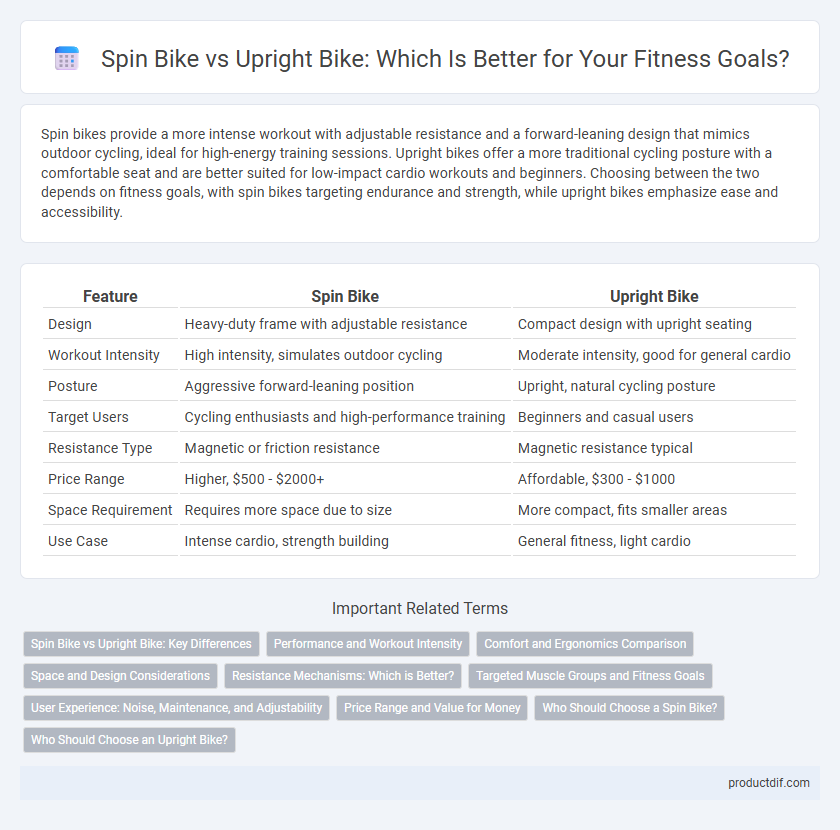Spin bikes provide a more intense workout with adjustable resistance and a forward-leaning design that mimics outdoor cycling, ideal for high-energy training sessions. Upright bikes offer a more traditional cycling posture with a comfortable seat and are better suited for low-impact cardio workouts and beginners. Choosing between the two depends on fitness goals, with spin bikes targeting endurance and strength, while upright bikes emphasize ease and accessibility.
Table of Comparison
| Feature | Spin Bike | Upright Bike |
|---|---|---|
| Design | Heavy-duty frame with adjustable resistance | Compact design with upright seating |
| Workout Intensity | High intensity, simulates outdoor cycling | Moderate intensity, good for general cardio |
| Posture | Aggressive forward-leaning position | Upright, natural cycling posture |
| Target Users | Cycling enthusiasts and high-performance training | Beginners and casual users |
| Resistance Type | Magnetic or friction resistance | Magnetic resistance typical |
| Price Range | Higher, $500 - $2000+ | Affordable, $300 - $1000 |
| Space Requirement | Requires more space due to size | More compact, fits smaller areas |
| Use Case | Intense cardio, strength building | General fitness, light cardio |
Spin Bike vs Upright Bike: Key Differences
Spin bikes feature a heavier flywheel and adjustable resistance, providing a more intense workout compared to upright bikes, which offer a more comfortable, traditional cycling posture. Upright bikes are designed for low-impact cardio and better back support, making them ideal for beginners or those with joint issues. The key differences lie in workout intensity, positioning, and target fitness goals, with spin bikes catering to high-intensity interval training and upright bikes focusing on endurance and rehabilitation.
Performance and Workout Intensity
Spin bikes offer higher performance potential and intense workout options due to their weighted flywheels and adjustable resistance settings, simulating real road cycling effectively. Upright bikes provide moderate workout intensity with a more casual riding posture, making them suitable for steady-state cardio but less ideal for high-intensity interval training. The advanced mechanics of spin bikes support vigorous endurance and strength exercises, enhancing calorie burn and cardiovascular fitness compared to upright bikes.
Comfort and Ergonomics Comparison
Spin bikes feature adjustable, padded seats and handlebars designed for aggressive posture, enhancing comfort during high-intensity workouts. Upright bikes offer a more upright seating position with broader seats, providing ergonomic support better suited for extended, low-impact exercise sessions. Ergonomic design in upright bikes reduces strain on the lower back, while spin bikes prioritize dynamic movement and core engagement.
Space and Design Considerations
Spin bikes feature a compact, streamlined design that fits well in smaller workout areas, maximizing space efficiency. Upright bikes typically occupy more floor space due to their larger frame and taller seating position. Choosing between these bikes depends on available room and aesthetic preferences, with spin bikes favored for tight spaces and modern gym setups.
Resistance Mechanisms: Which is Better?
Spin bikes typically use magnetic or friction resistance mechanisms, offering smooth, adjustable intensity ideal for high-intensity interval training and simulating outdoor cycling. Upright bikes often rely on magnetic resistance, providing consistent, quieter, and low-maintenance performance suited for steady-state cardio workouts. Choosing between the two depends on workout style preferences, with spin bikes favoring aggressive resistance control and upright bikes emphasizing durability and ease of use.
Targeted Muscle Groups and Fitness Goals
Spin bikes primarily target the quadriceps, hamstrings, glutes, and calves while engaging the core for stability, making them ideal for high-intensity cardio and strength training. Upright bikes emphasize the lower body muscles similarly but offer a more upright posture that reduces strain on the lower back, benefiting users aiming for moderate endurance and low-impact cardiovascular workouts. Both bikes support fat loss and improve leg strength but differ in intensity and muscle engagement based on riding position and resistance settings.
User Experience: Noise, Maintenance, and Adjustability
Spin bikes produce lower noise due to their belt-driven systems compared to the louder chain mechanisms in upright bikes, enhancing home workout comfort. Maintenance for spin bikes tends to be minimal, requiring occasional belt tension checks, while upright bikes need frequent lubrication and chain adjustments. Both bike types offer adjustable seats and handlebars, but spin bikes provide a wider range of settings for customized fit and better ergonomics during intense training sessions.
Price Range and Value for Money
Spin bikes generally fall within a higher price range, typically between $500 and $1,500, offering robust features suited for intense workouts and professional use. Upright bikes are often more affordable, ranging from $200 to $800, providing solid value for money for casual to moderate exercise routines. When assessing value, spin bikes deliver enhanced durability and performance for serious cyclists, while upright bikes offer cost-effective options for beginners seeking basic cardiovascular benefits.
Who Should Choose a Spin Bike?
Fitness enthusiasts seeking intense, high-resistance workouts should choose a spin bike, as it simulates outdoor cycling with customizable resistance levels and a forward-leaning posture that enhances cardio and leg muscle engagement. Athletes aiming to improve cycling performance and endurance benefit from the spin bike's ability to mimic real-road conditions, offering a robust, low-impact exercise option. Beginners or those focused on casual, low-intensity exercise might find upright bikes more comfortable, but serious cyclists prioritize spin bikes for their precision and durability.
Who Should Choose an Upright Bike?
Upright bikes are ideal for users seeking a traditional cycling experience with an emphasis on outdoor road bike simulation and improved posture engagement. Fitness enthusiasts aiming to enhance cardiovascular health with moderate intensity workouts benefit from the upright design, which allows natural body positioning and greater core activation. Rehabilitation patients and beginners often prefer upright bikes for their stability and ease of mounting compared to spin bikes, making them suitable for low-impact exercise and injury recovery.
Spin Bike vs Upright Bike Infographic

 productdif.com
productdif.com